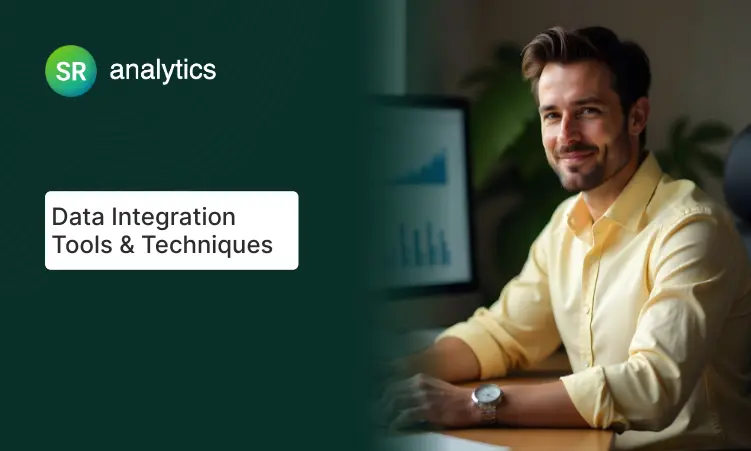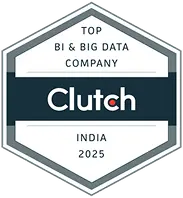Highlights
- Agentic AI transforms data analysis by automating decision workflows. Gartner reports 65% of D&A leaders will pilot AI agents by end of 2025
- Decision intelligence platforms combine AI and analytics to improve decision speed by 5-10x according to McKinsey research
- Organizations with mature data practices achieve 23x higher customer acquisition rates and 19x profitability
- Edge computing will process 75% of enterprise data by 2025, enabling real-time decisions at the source (IDC forecast)
- Small language models deliver 40% more accurate domain-specific insights while reducing computational costs by 70%
Introduction
The global data analytics market will reach $140 billion by 2025 (Statista), but technology alone won’t create competitive advantage. McKinsey’s research reveals that companies excelling in data analytics are 23 times more likely to acquire customers, 6 times more likely to retain them, and 19 times more likely to be profitable.
The difference? Strategic implementation of emerging trends that transform data from reactive reporting to proactive decision-making.
2025 marks a fundamental shift in how organizations extract value from data. Technologies like agentic AI, decision intelligence platforms, and edge analytics are redefining the landscape by moving beyond traditional business intelligence to create autonomous, self-optimizing systems.
This guide explores the data and analytics trends separating industry leaders from followers, with actionable strategies for mid-market organizations ready to compete on insights.
Quick Answer:
Data and analytics trends 2025 center on AI-driven automation, decision intelligence, and edge computing. Organizations adopting agentic analytics and multimodal data fabrics achieve 23x customer acquisition rates and 60% faster decision-making versus traditional approaches.
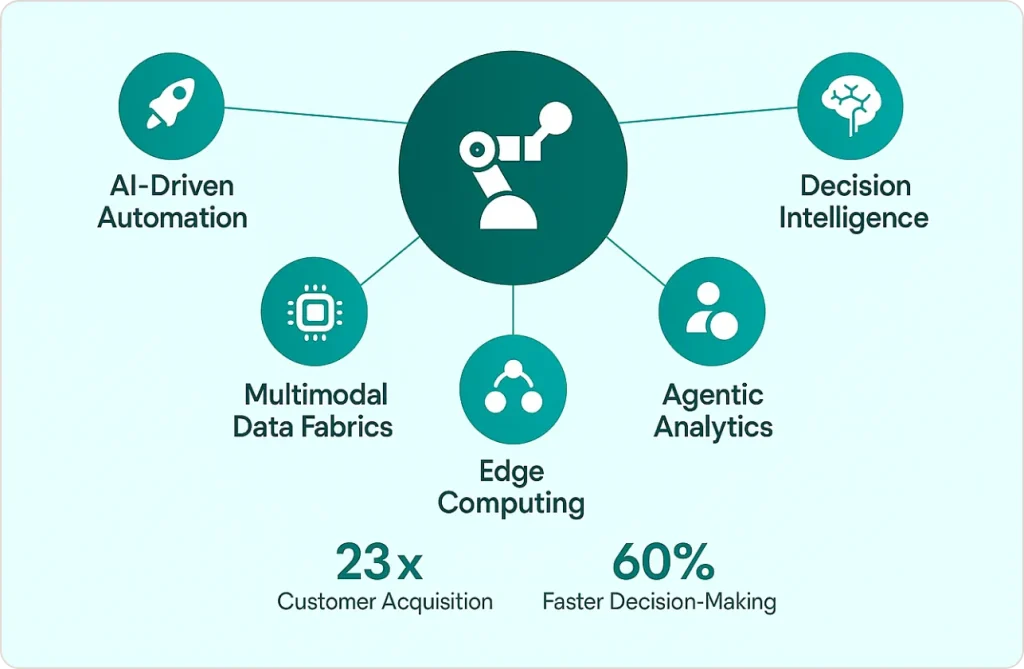
1. Agentic AI: Autonomous Analytics That Never Sleep
Agentic AI represents a paradigm shift from static dashboards to autonomous analytics systems. Rather than waiting for humans to query data, AI agents continuously monitor information streams, identify patterns, execute analyses, and trigger actions without manual intervention.
Gartner’s 2025 Data & Analytics Trends identifies agentic analytics as transformative, noting that “automating closed-loop business outcomes with AI agents for data analysis enables flexible, complex adaptive automation that goes far beyond traditional rules-based systems.”
Real-World Impact
JPMorgan Chase deployed agentic AI across fraud detection systems, reducing false positives by 25% while identifying 40% more actual fraud cases. The system automatically adjusts detection parameters based on emerging patterns without requiring data scientist intervention.(source)
Cleveland Clinic’s AI agents analyze patient data across 100+ variables in real-time, predicting sepsis onset 6-12 hours before symptoms appear. This autonomous monitoring has reduced sepsis mortality rates by 18%.(source)
Amazon’s AI agents automatically rebalance inventory across distribution centers based on demand predictions, weather patterns, and logistics constraints, reducing stockouts by 35% while cutting inventory carrying costs by 12%.(Source)
Implementation Strategy
Successful deployments combine real-time data pipelines with latency under 5 seconds, comprehensive metadata management for context, robust data quality controls aiming for 95%+ accuracy, and API-first architecture enabling agent-to-application communication.
Start by identifying repetitive analytical tasks consuming analyst time, then pilot a single high-impact use case with clear governance frameworks. Data analytics services can accelerate this journey by establishing AI-ready infrastructure and governance models.
Expert Insight: “AI agents are valuable for ad hoc, flexible, or complex adaptive automation needs. The key is ensuring they can access integrated data across your entire ecosystem, not just isolated databases.” Gareth Herschel, VP Analyst at Gartner (Source)
2. Decision Intelligence: From Data-Driven to Decision-Centric
Most organizations drown in data but starve for decisions. McKinsey research reveals only 37% of executives say their organizations make both high-quality and high-velocity decisions. The future of data analytics isn’t more dashboards but decision intelligence platforms that combine data, AI, and business context to recommend specific actions.
Decision intelligence moves beyond answering “what happened?” to address “what should we do?” These platforms integrate predictive analytics forecasting multiple scenarios, prescriptive recommendations with confidence scores, automated decision execution for routine choices, and human-in-the-loop escalation for complex situations.
Measurable Business Impact
A mid-market automotive supplier implemented decision intelligence for production scheduling. The system analyzes order patterns, equipment availability, material constraints, and quality metrics to automatically adjust production sequences. Result: 28% improvement in on-time delivery and 15% reduction in overtime costs.
Organizations implementing DI platforms report 5-10x faster decision-making (McKinsey), 60% reduction in analysis-to-action time, 32% higher profitability (Deloitte Tech Trends), and 40% decrease in decision-making meetings.
Building Your Foundation
Start by identifying your organization’s most critical decisions. Which decisions have the highest business impact? What data sources inform each decision? How quickly must decisions be made?
Use predictive analytics to model multiple futures. Data science services can simulate demand scenarios under different market conditions, pricing strategies across customer segments, and resource allocation optimization.
Implement automated execution with clear governance including decision authority frameworks, audit trails for all automated decisions, override mechanisms for human intervention, and regular model performance reviews.
3. Small Language Models: Domain Expertise Over Generic AI
While large language models dominate headlines, Gartner’s 2025 trends highlight a countertrend: small language models (SLMs) deliver more accurate, contextually appropriate outputs for specific business domains.
The SLM advantage includes 40% better performance on domain-specific tasks, 70% lower computational requirements versus LLMs, 3-5x faster response times, deployable on-premises for sensitive data, and fine-tuning with proprietary datasets.
Industry Applications
A regional hospital network deployed SLMs trained on medical literature and internal patient data. The model achieved 92% accuracy in suggesting diagnostic pathways versus 67% for general-purpose LLMs while maintaining HIPAA compliance through on-premises deployment.
A credit union implemented SLMs for loan underwriting, training models on 15 years of loan history. Processing time dropped from 3 days to 4 hours, with 15% improvement in default prediction accuracy.
Generative AI services can help establish robust training pipelines, implement monitoring for model drift, and create update cycles as business context evolves.
4. Multimodal Data Fabrics: Breaking Integration Gridlock
Most organizations struggle with customer data in Salesforce, financial data in ERPs, operational data in legacy systems, and IoT data in cloud platforms. Traditional integration approaches create brittle point-to-point connections that break constantly.
Multimodal data fabrics solve this through intelligent architectures that automatically discover, connect, and orchestrate data across disparate sources. These fabrics handle structured data, unstructured data, streaming data, graph data, and time-series data simultaneously.
Real Results
Cleveland Clinic unified electronic health records, research databases, imaging systems, and genomic data through a multimodal fabric. The impact: 40% faster drug discovery, reduced patient identification time from weeks to hours for clinical trials, real-time risk scoring across 200+ variables, and automated audit trails for regulatory compliance.(Source)
JPMorgan Chase implemented data fabric for real-time fraud detection, connecting transaction data, customer profiles, merchant information, and global fraud patterns. Results included 25% reduction in false positives, 30% improvement in actual fraud detection, and sub-second analysis latency.(Source)
Building Your Strategy
Start with metadata management foundations covering technical metadata (data types, schemas, lineage) and business metadata (definitions, ownership, quality metrics). Implement automated data cataloging across all sources, lineage tracking from source to consumption, and data quality monitoring with alerting.
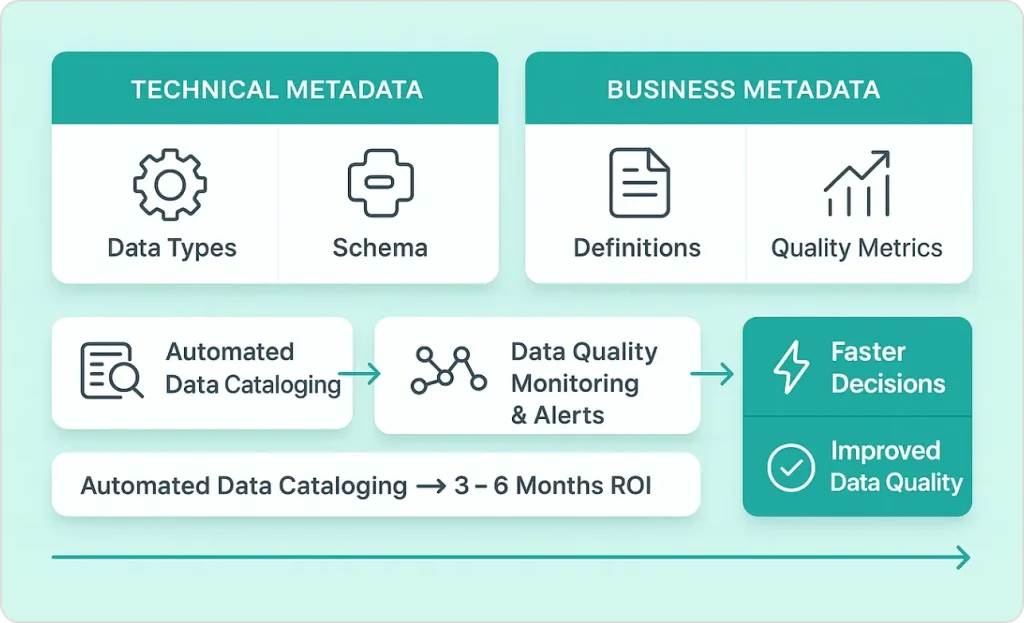
Data engineering services provide expertise in deploying AI-driven data pipelines that auto-discover new data sources, recommend optimal integration patterns, and self-heal when connections break.
5. Data Products: Treating Analytics as Strategic Assets
Traditional analytics operates in project mode: business requests report, IT builds it, project closes. This creates one-off solutions, duplicated effort, and zero reusability.
The data product approach treats data as a productized asset with dedicated ownership and roadmaps, quality guarantees and SLAs, self-service access and documentation, continuous improvement cycles, and clear value metrics.
McKinsey projects that by 2025, successful organizations will treat data assets as products, with dedicated squads aligned against them to embed data security, advance data engineering, and implement self-service access.
Building Reusable Assets
Rather than each department building separate customer views, a unified Customer 360 product provides consistent, real-time data through role-specific interfaces. Marketing sees campaign response, Sales accesses account history, Finance reviews payment patterns, and Support examines ticket history.
Organizations implementing data product thinking report 60% reduction in duplicated data preparation effort, 40% faster time-to-insight for business users, 70% decrease in IT support tickets for analytics, and 2.5x better business outcomes overall (IDC).
Select data assets that multiple teams request repeatedly, drive critical business decisions, and have clear business value metrics. Common first products include customer analytics, operational metrics, financial reporting, and inventory optimization.
6. Edge Analytics: Real-Time Intelligence at the Source
Traditional analytics follows a centralized model: collect data from all sources, transmit to cloud or data center, process, then deliver insights. This works for retrospective analysis but fails for real-time use cases requiring instant decisions.
Edge analytics processes data at or near the source (IoT devices, store locations, vehicles, equipment), enabling real-time decisions without cloud roundtrips. IDC projects that by 2025, 75% of enterprise-generated data will be processed at the edge.
The Speed Advantage
Cloud roundtrips add 50-200ms latency. Edge processing delivers insights in under 10ms, critical for autonomous vehicles, industrial automation, and fraud detection. A manufacturing plant might generate 1TB of sensor data daily. Edge analytics process data locally, transmitting only insights (99% data reduction), slashing bandwidth costs.
Proven Applications
UPS deployed edge analytics in delivery vehicles, analyzing real-time traffic, weather, and delivery windows. The system dynamically reroutes drivers throughout the day, cutting fuel costs by 10% and improving on-time delivery by 12%.(Source)
Siemens’ smart factories run edge analytics on production equipment, monitoring vibration, temperature, and performance patterns. The system predicts equipment failures 24-48 hours in advance, automatically scheduling maintenance and reducing unplanned downtime by 30%.(Source)
Walmart processes point-of-sale and inventory data at store locations, automatically triggering restocking and adjusting pricing. Edge analytics enable decisions in seconds versus hours required for central processing, reducing stockouts by 25%.(Source)
This highlights the essential data analytics trends for 2024 and beyond, focusing on how advancements like data democratization, AI integration, embedded analytics, and real-time IoT data are shaping the future of the industry. It also covers practical applications and tools that empower businesses to leverage these innovations effectively.
Strategic Implementation: Your 90-Day Action Plan
Month 1: Assessment and Prioritization
Conduct current state analysis by auditing existing analytics capabilities, documenting pain points from business stakeholders, inventorying data sources and integration challenges, assessing team skills and gaps, and benchmarking against industry standards.
Map trends to specific business objectives, calculate potential ROI for each initiative, identify quick wins versus long-term investments, secure executive sponsorship, and define success metrics.
Month 2: Foundation Building
Evaluate data quality and completeness, review integration architecture, assess governance and security controls, identify technical debt requiring remediation, and plan infrastructure investments.
Select one high-value, achievable use case: agentic AI for automated reporting, decision intelligence for key business processes, edge analytics for real-time operations, or data product for commonly requested analysis.
Month 3: Pilot and Scale
Execute your pilot by implementing the selected use case, gathering user feedback continuously, measuring business impact metrics, documenting lessons learned, and refining approach based on results.
Identify the next wave of use cases, allocate budget and resources, establish a center of excellence, create reusable templates and patterns, and plan organizational change management.
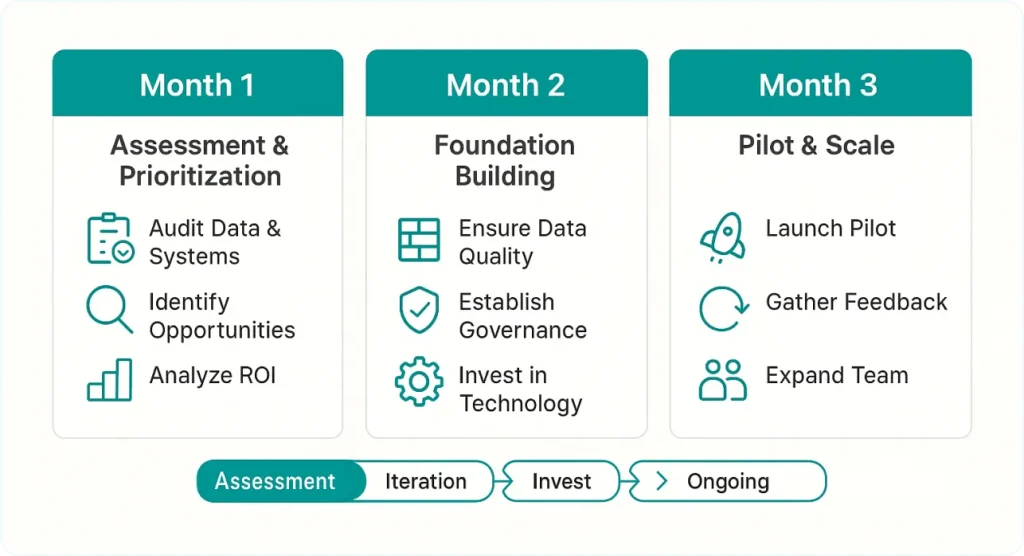
Organizations succeeding with data analytics initiatives 2025 share common characteristics: strategic focus aligning investments with business objectives, pragmatic implementation starting small and scaling systematically, skills investment prioritizing upskilling, governance balance enabling broad access within compliance boundaries, and continuous evolution.
Conclusion: Your Path Forward
The global data analytics market’s growth to $140 billion by 2025 signals massive opportunity, but success requires strategic implementation of emerging trends rather than chasing every technology.
Organizations achieving 23x customer acquisition rates and 19x profitability gains share a common approach: they align data analytics initiatives with specific business objectives, start with high-value pilots proving ROI quickly, invest in upskilling existing teams, balance democratized access with appropriate governance, and treat analytics as evolving products.
The six data and analytics trends reshaping 2025 provide your roadmap: agentic AI transforming analytics from reactive to autonomous, decision intelligence moving organizations from data-driven to decision-centric, small language models delivering domain-specific accuracy, multimodal data fabrics breaking integration gridlock, data products treating analytics as reusable assets, and edge analytics enabling real-time decisions at the source.
Success demands action. Assess which trends align with your top business priorities this week. Identify one high-value use case for pilot implementation within 30 days. Execute a focused pilot with clear success metrics over 90 days. Then scale systematically based on proven business impact.










